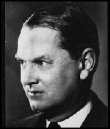It Should Rhyme with 'Laugh': Humor in Waugh

by Ralph McInerny
University of Notre Dame
"...Evelyn Waugh (1903-1966) once began a book review thus: “There are three kinds of writer: those who know how to write and have nothing to say, those who have something to say but don't know how to write, and the rest are at meetings speaking of the agony of creation.” Waugh himself knew how to write, had something to say, and seems never to have indulged in the usual self-pity of the creative writer.
Before he found his way as a writer, he dabbled in the graphic arts — the illustrations in Black Mischief are by the author — and cabinet making. His first novel, Decline and Fall, appeared in 1928 and already displayed a mastery of his craft that is unusual at the outset of a literary career. From that point on, with few exceptions, his novels are models of the art that conceals itself, like well-made cabinets. A careful study of them could save the aspiring writer a good deal of the agony of creation. But the initial reaction to most of his novels is laughter. They are funny. Hilariously funny. Humor, one sometimes thinks, is the best medium for seriousness. From the very first novel, the reader finds, as the laughter dies, a residue of usually unstated or understated gravitas.
For all that, readers of Decline and Fall and Vile Bodies (1930), those who ran as they read, could have been forgiven if they thought of him as merely a comic writer. P.G. Wodehouse, whose writing Waugh, like Hilaire Belloc, held in high esteem, was the object of close study. Jeeves and Psmith, the golf stories the Mulliner stories, the whole Wodehouse canon, provides hours of shrieking pleasure for the reader. Now, it is a truism that the explained joke is never a joke. There is a vast and humorless library on the nature of humor. To Wodehouse can easily be applied Oscar Wilde's dictum that we laugh and we are not wounded. We find in his journalism and reviews Waugh's appreciation of Wodehouse.
The world of Wodehouse seems self-contained—the Drones Club is unlike any real club, Wodehouse's limp young men do not find their counterparts among the living, the stories turn on issues of consummate triviality, the pursuit of a young woman is on a par with the pursuit of a lost golf ball, but no Wodehouse golfer would be permitted on any respectable course. Waugh's 1939 essay on the work of Wodehouse is called “An Angelic Doctor.” It is clear that Waugh was a close student of this comic master and what he has to say of him casts indirect light on himself.
Wodehouse's characters, Waugh asserts, are “purely and essentially literary characters.”
We do not concern ourselves with the economic implications of their position; we are a bit skeptical about their quite astonishing celibacy. We do not expect them to grow any older, like the Three Musketeers or the Forsytes. We are not interested in how they would ‘react to changing social conditions' as publishers' blurbs invite us to be interested in other sagas. They are untroubled by wars…(p. 255)..."
Read on...
<< Home